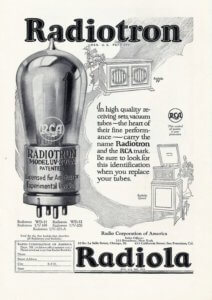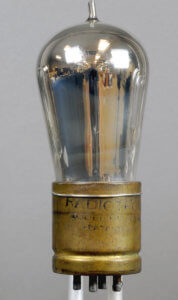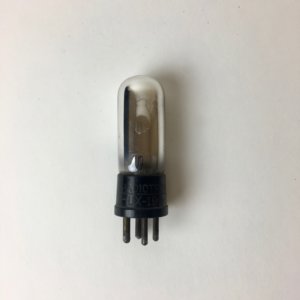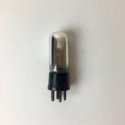What happens when the radio craze gets mixed up with a production line mistake? You get the UX-199, a popular general purpose vacuum tubes in the 1920s.
The UV-199 came about because of a mistake. In the early 20th century, General Electric’s Harrison Lamp Works was very busy manufacturing light bulbs for a rapidly electrifying America. Adding to its already large workload, in the late 1910s, the plant also began to manufacture vacuum tubes, the lamp-like devices that were revolutionizing electronics.[1] In 1920, General Electric released the UV-200 and UV-201, manufacturing them in their Harrison Lamp Works. This was the first vacuum tube that the Radio Corporation of America (RCA) ever marketed, and although RCA would later go on to market (and later manufacture) billions of tubes, in the first decade of its life, the company’s main purpose was to provide ship-to-ship or ship-to-shore telegraphic communication. It did, however, serve as the distributing arm of General Electric and Westinghouse thanks to cross-licensing agreements signed with those two companies in 1920.[2]

Sarnoff Collection Digital Archive
However, sometime in late 1920, there was a problem in the Harrison Lamp Works. The UV-201 (as well as many of the lightbulbs produced by the facility) normally used a tungsten filament wire, but some in some of these tubes the filament was accidently contaminated with thorium dioxide, a compound often used in incandescent gas mantles. Rather than ruin the batch, researchers at GE quickly realized that these thoriated filaments allowed the tubes to work at a lower filament temperature. Intensive research ensued to create new, more efficient filaments. After creating some specialty tubes for the Navy, the Harrison plant began to manufacture the first commercially available thoriated tubes, the UV-201a (which was functionally equivalent to the UV-201), and the UV-199.[3] The latter tube was a three-electrode general purpose triode developed for use with dry-cell batteries, the most common battery type for home electronic use.

S.295.5
The UV-199, which was publicly announced at the New York Radio Show in December 1922, was plagued with problems. Structurally, however, it was interesting. It was the last RCA tube to use very short pins—they were 1/8-inch long, and springs in the socket would make the connection on the end (in something called a bayonet slot). By August of 1925, RCA replaced the UV-199 with the UX-199. The UX-199 had none of the problems of the UV-199, and it also did away with the shorter pins. In fact, RCA never used this type of base again, and the longer pins became standard. The tube was manufactured until 1931, even though almost no new receivers used the UX-199 tube after 1927.[4] The UX-199 in the Sarnoff Collection is from after 1927, which we can date because our tube has nickel-plated contact pins, which RCA introduced in that year.

S.796.14
Text by: Florencia Pierri
[1] “Harrison/ West Newark Lamp Works,” http://www.lamptech.co.uk/Documents/Factory%20-%20US%20-%20Harrison.htm
[2] For a timeline of RCA’s history, see RCA: How a Company Became an Industry, https://davidsarnoff.tcnj.edu/timelines/rca-how-a-company-became-an-industry/
[3] Gerald F. J. Tyne, Saga of the Vacuum Tube. (Indianapolis: Howard H. Sams and Co., 1977), 313.
[4] Ibid., pp. 313-314.

